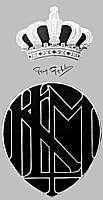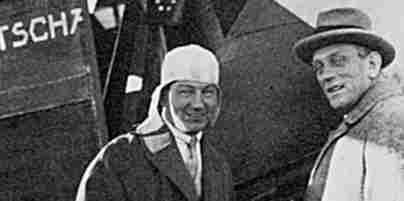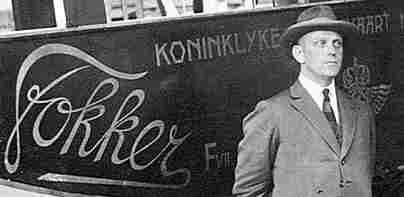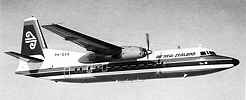

| Anthony Fokker |  | Albert Plesman |
characters clash in character clashes
| Dutch aviation started out with the cooperation between Fokker's Vereenigde Vliegtuigfabriek of Amsterdam and KLM Koninklijke Luchtvaartmaatschappij/Royal Dutch Airlines. With the introduction of the all-metal plane, Fokker's wooden construction lost out and KLM switched to Douglas and, later, still other aircraft. Ultimately, this came about because of the fights and quarrels between Fokker and KLM director Albert Plesman. On this indexed page, you're given the gist of several aspects of the story. The links give more background; the notes give the source, of which there's a list. |
 |
 Anthony Fokker and Albert Plesman |
| As I understand the man, he was somewhat of a playboy, who couldn't be bothered with hassles. He was best at test flying airplanes; took them up for a hop and told you what had to be changed - and was right, too. Most info on Fokker is in Dutch, naturally. Bio: Born in Dutch Indonesia in a wealthy Dutch family. He never finished high school. Was fascinated by the young art of flying and burned a lot of his family's money trying to get his own airplanes built, flown and sold. In World War I, building aircraft in Germany, he made a fortune, which he quite illegally moved to Holland. There he started building aircraft, not only for KLM. For over ten years, Fokker aircraft were the best in the world, built in concession all over. Three American Fokker factories adapted and built models developed in Holland. With the advent of the all-metal planes from the USA, Fokker's days as an aircraft manufacturer seemed to be over, as he stubbornly stuck to wooden construction. He died in 1939 in the USA. The Fokker factories kept building aircraft well into the late 1990s. There's much more to the story than this standardized version. |
 |
| Albert Plesman |
| In his time, quite as famous in Holland as director of KLM as Fokker, but very different in character. Born and raised in Holland with a rigid religious background. His stubborn and unyielding attitude led to many problems with his collaborators. As an army officer he was the main force behind KLM's 1920 start, Amsterdam-London with De Havilland DH-16. They were very soon replaced with four passenger cabin Fokker F-II, and from then on KLM used almost exclusively Fokker aircraft, till the introduction of the Douglas DC-2. In WWII KLM was kept alive mainly by the West-Indian division, and then made an amazing come-back flying Douglas, Lockheed and Convair aircraft. The F-27 Friendship was the first Fokker KLM used again. |
 |  |  |
| Fokker F-24, 1939 | Fokker F27, 1958 | Douglas DC-5, 1939 |
 Time-Line |
| I never found a description of the Fokker-Plesman relationship per se; in their biographies etc. there are to be found a lot of loose remarks that hang together. Below some highlights from a more |
| detailed time line |
| 1920 | Anthony Fokker moves his factory from Germany to Amsterdam Albert Plesman starts KLM Royal Dutch Airlines for Holland and Colonies |
| 1921 | Fokker sells first F-II to KLM |
| 1922 | KLM gets 4-year subsidy; Fokker exports 200 aircraft at ƒ5M. |
| 1924 | After a quarrel on the design competition for a tri-motor Plesman calls FokkerNot totally responsible for his remarks First East-India flight, Fokker F-VII |
| 1925 | Fokker builds F-VIIa tri-motor KLM starts explosive growth |
| 1929 | Due to The Crash, Fokker America goes to General Motors Amsterdam produces only 67 aircraft KLM continues growing, an international exception. |
| 1930 | First KLM strike; Fokker F-IX |
| 1931 | Fokker F-II/F32, 30 passengers F-XVIII, last model based on F-VII. |
| 1933 | Fokker F-36 32 passengers 4 engines KLM orders Douglas DC-2 |
| 1934 | KLM "wins" Melbourne race with DC-2 UiverFokker acquires European licensing rights from DC-1 up |
| 1935 | KLM first trans-Atlantic mail, start West Indian operations with Fokker F-XVIII Snip |
| 1939 | KLM orders DC-5 and F-24 first all-metal Fokker plane; Anthony Fokker dies in Manhattan |
| 1940-1945 | KLM flies Bristol-Lisboa and West-India. Fokker factories work for German war industry |
| 1946 | KLM orders Convair Liner, not F-24 |
| 1958 | Fokker F-27 Friendship based on F-24 KLM buys three |
| 1953 | Plesman dies |
| 1986 | KLM buys ten Fokker F100 with options on five more to phase out Douglas MD-80s. |
| ~1995 | Fokker goes bankrupt |
| 2004 | KLM taken over by Air France |
| to sum up Before World War II, there have been at least nine aircraft manufacturers in Holland. The most important of these were Koolhoven of Rotterdam, Pander den Haag and of course Fokker. The only Dutch airline was KLM. While KLM bought almost exclusively Fokker aircraft, personality clashes between Plesman and Fokker ultimately led to a refusal of Plesman to deal with him anymore, and he switched over to all-metal Douglas planes. Because Fokker had bought the European rights for these, he made a lot of money and did start out manufacturing all-metal aircraft. In 1939 KLM bought, under Dutch government pressure, four each of the virtual twins DC5 and F-24 (which were never built). |
| would be nice to know According to the official story on the DC-2 licensing rights, Fokker's letter to Douglas got there two weeks before KLM's and Plesman was furious. But was he? His son innocently relates when and how Plesman gave away the secret to Fokker, who must have sent Douglas a cable that same night. Plesman probably did this to help along what was, after all, a long-time business companion. Why the furious act in public? Maybe because he'd rather not have the Dutch tax-payer know how come he had to pay the extra money Douglas asked for Fokker's commission. All in all, this matter wants some serious investigation. |
caveat emptor
When I set out to collect these facts, I didn't care much one way or the other in terms of personal preference. However, gradually a strong feeling of sympathy for Fokker as opposed to Plesman started taking hold of me. No doubt partly because, like Fokker, I was born in a colony and never had any patriotic feelings so's you'd notice for a mother country essentially strange to me — or, if truth be told, even worse. Still stronger, and probably related to that, the stiff unbending mentality of a professional military man, as Plesman was, just stuck in my throat and made me gag. Just a personal hang-up of course, and I have taken care not to let this influence my research. However, I'm well aware it shines through, and there was no way I could escape its influence on my conclusions in the entire affair. Don't let this turn you off, please.
What has really taken me in for the man Fokker, no matter if he was irreliable in business dealings, which he was, is that whenever you see a photograph of him in a cockpit, he is
beaming like a searchlight.

Index
Tony Fokker
Albert Plesman
F-36 Arend
Melbourne Race
The Great Races
Sources
Time-Line
Time-Line, complete
Wood or Metal?
SEARCH this site or the Web

copyright notice
all material on this site, except where noted
copyright © by , curaçao
reproduction in any form for any purpose is prohibited
without prior consent in writing